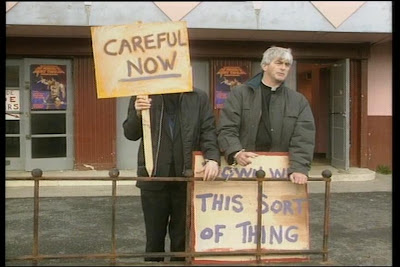

I continue to return to the X-files as something I admire and am in awe of. I say this not simply because the X-Files was my chosen object for the junior-high obession phase of my life, nor because to this day, if I were to taylor-make the phsyical specifications of an ideal man, he would undoubtedly be either David Duchnovy or Jim Sturgess, but because after retrospective examination and, I hope, a better sense of objective consideration, I think the show actually did a number of things very well. In particular, the dual ability to portray something at this at immediate in its enterainment value - compelling, interesting, and unique, while aslo more subtlely (or perhaps not) addressing much bigger things. The show grapples, of course, with huge, metaphysical issues both literally and more symbolically, but does so in such a way that the audience may not even realize what truly meaningful points are being raised. "I want to Believe" and "Trust no one" are iconic phrases, easily dismissed as part-and-parcel of a show dedicated to paranoia and drama. But for me, the way the show considers these big ideas using the specifc storylines of government cover-ups, alien abductions, and folklore finding real atecedents, allows me to temporarily forget about the biases I have when thinking about belief in my own life. Not to be too revealing or self-indulgent, but as a person who once felt a great presence of faith in my personal life and then progressively lost that sense of faith, the phrase "I want to believe" is incredibly compelling because it is true. What I think mainstream attempts for conversion or even discussion of belief are missing is that sometimes it is best to consider the basis of belief, the desire for it, and its relatioship to who you are in a whole different context.
For another example, listen to this great
NPR interview with David Duchovny, who I deem a perfectly legitimate scholarly reference, by the way, since he was on his way to a masters degree in English from Princeton before changing paths in life. As you will hear, for him, the episode where a player in the Negro League turns out to be an alien, while entetaining in its own right, is also playing with the themes of aliens and alientation. fantastic.
To weave these additional layers of meaning into otherwise creative/entertaining projects takes talent. Making direct statements about these topics often falls flat, has no appeal, and no staying power. And making the creative material that is basically the mental equivalent of eating popcorn makes no demands of the intellect at all.
This duality of the xfiles, to be at once entertaining and enjoyable and, upon closer, nerdier inspection, an attempt to explore something much larger and more universal, is something I admire in a number of forms of enterainment. Jonathan Coulton songs, for instance.
It is a perfeclty nerdy thing to do . . . take something well beyond its face value and inscribe great levels of meaning and significance to all its actions. The same fervor with which I applied my interest in knowing episode names and quotes as a 7th grade girl has morphed into an adult interest in the larger structure, the behind-the-scenes creative work which directed these fascinating details into a compelling story. This nerdy tendency is perhaps why shows like the X-Files or music like Jonathan Coulton's is so interesting to those of us who over-analyize a little too much.

























